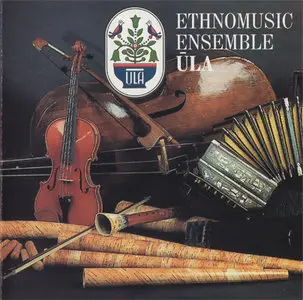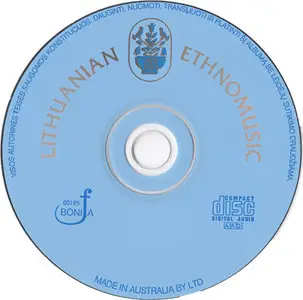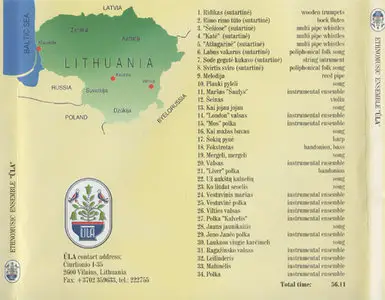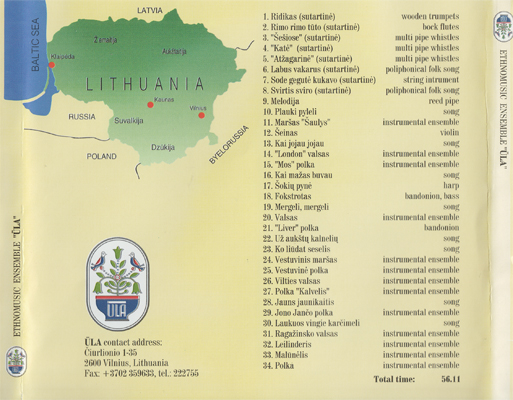Ethnomusic Ensemble ULA - Ethnomusic Ensemble ULA
EAC+LOG+CUE | FLAC: 307 MB | MP3 CBR 320: 145 MB | Full Artwork | 5% Recovery Info
Label/Cat#: Bonifa # 00195 | Country/Year: Lithuania 1995
Genre: Folk & World | Style: Baltic Folk
MD5 [X] CUE [X] LOG [X] INFO TEXT [X] ARTWORK [X]
webfind [] selfrip [X]
Exact Audio Copy V1.0 beta 2 from 29. April 2011
EAC extraction logfile from 26. April 2012, 11:53
Ûla / Etnomusic ensemble 'Ûla'
Used drive : PIONEER BD-RW BDR-206 Adapter: 2 ID: 3
Read mode : Secure
Utilize accurate stream : Yes
Defeat audio cache : Yes
Make use of C2 pointers : No
Read offset correction : 667
Overread into Lead-In and Lead-Out : No
Fill up missing offset samples with silence : Yes
Delete leading and trailing silent blocks : No
Null samples used in CRC calculations : Yes
Used interface : Native Win32 interface for Win NT & 2000
Used output format : User Defined Encoder
Selected bitrate : 896 kBit/s
Quality : High
Add ID3 tag : No
Command line compressor : C:\Program Files\FLAC\flac.exe
Additional command line options : -5 -T "Artist=%artist%" -T "Title=%title%" -T "Album=%albumtitle%" -T "Date=%year%" -T "Tracknumber=%tracknr%" -T "Genre=%genre%" %source% -o %dest%
TOC of the extracted CD
Track | Start | Length | Start sector | End sector
––––––––––––––––––––––––––––-
1 | 0:00.30 | 0:53.43 | 30 | 4047
2 | 0:53.73 | 0:49.49 | 4048 | 7771
3 | 1:43.47 | 0:52.37 | 7772 | 11708
4 | 2:36.09 | 0:44.39 | 11709 | 15047
5 | 3:20.48 | 1:13.17 | 15048 | 20539
6 | 4:33.65 | 0:58.59 | 20540 | 24948
7 | 5:32.49 | 1:42.26 | 24949 | 32624
8 | 7:15.00 | 1:08.32 | 32625 | 37756
9 | 8:23.32 | 1:44.66 | 37757 | 45622
10 | 10:08.23 | 2:02.42 | 45623 | 54814
11 | 12:10.65 | 1:06.22 | 54815 | 59786
12 | 13:17.12 | 1:10.08 | 59787 | 65044
13 | 14:27.20 | 1:58.57 | 65045 | 73951
14 | 16:26.02 | 2:25.73 | 73952 | 84899
15 | 18:52.00 | 2:21.20 | 84900 | 95494
16 | 21:13.20 | 2:31.00 | 95495 | 106819
17 | 23:44.20 | 2:46.23 | 106820 | 119292
18 | 26:30.43 | 1:20.27 | 119293 | 125319
19 | 27:50.70 | 1:36.29 | 125320 | 132548
20 | 29:27.24 | 1:30.58 | 132549 | 139356
21 | 30:58.07 | 1:34.56 | 139357 | 146462
22 | 32:32.63 | 3:00.00 | 146463 | 159962
23 | 35:32.63 | 1:21.64 | 159963 | 166101
24 | 36:54.52 | 1:21.73 | 166102 | 172249
25 | 38:16.50 | 2:07.37 | 172250 | 181811
26 | 40:24.12 | 2:10.19 | 181812 | 191580
27 | 42:34.31 | 1:30.41 | 191581 | 198371
28 | 44:04.72 | 1:22.43 | 198372 | 204564
29 | 45:27.40 | 1:39.09 | 204565 | 211998
30 | 47:06.49 | 2:51.27 | 211999 | 224850
31 | 49:58.01 | 1:56.48 | 224851 | 233598
32 | 51:54.49 | 1:26.62 | 233599 | 240110
33 | 53:21.36 | 1:32.34 | 240111 | 247044
34 | 54:53.70 | 2:22.53 | 247045 | 257747
Range status and errors
Selected range
Filename I:\=== VINYL RIPS ===\=== EAC===\X FRESH RIP\Ûla - Etnomusic ensemble 'Ûla'.wav
Peak level 100.0 %
Extraction speed 7.6 X
Range quality 100.0 %
Test CRC 1D1E8479
Copy CRC 1D1E8479
Copy OK
No errors occurred
AccurateRip summary
Track 1 not present in database
Track 2 not present in database
Track 3 not present in database
Track 4 not present in database
Track 5 not present in database
Track 6 not present in database
Track 7 not present in database
Track 8 not present in database
Track 9 not present in database
Track 10 not present in database
Track 11 not present in database
Track 12 not present in database
Track 13 not present in database
Track 14 not present in database
Track 15 not present in database
Track 16 not present in database
Track 17 not present in database
Track 18 not present in database
Track 19 not present in database
Track 20 not present in database
Track 21 not present in database
Track 22 not present in database
Track 23 not present in database
Track 24 not present in database
Track 25 not present in database
Track 26 not present in database
Track 27 not present in database
Track 28 not present in database
Track 29 not present in database
Track 30 not present in database
Track 31 not present in database
Track 32 not present in database
Track 33 not present in database
Track 34 not present in database
None of the tracks are present in the AccurateRip database
End of status report
==== Log checksum 45EE9EF6B83E9751EBB83CDE188A74980AD2EFB5DC76823D790C8576AE16509B ====
EAC extraction logfile from 26. April 2012, 11:53
Ûla / Etnomusic ensemble 'Ûla'
Used drive : PIONEER BD-RW BDR-206 Adapter: 2 ID: 3
Read mode : Secure
Utilize accurate stream : Yes
Defeat audio cache : Yes
Make use of C2 pointers : No
Read offset correction : 667
Overread into Lead-In and Lead-Out : No
Fill up missing offset samples with silence : Yes
Delete leading and trailing silent blocks : No
Null samples used in CRC calculations : Yes
Used interface : Native Win32 interface for Win NT & 2000
Used output format : User Defined Encoder
Selected bitrate : 896 kBit/s
Quality : High
Add ID3 tag : No
Command line compressor : C:\Program Files\FLAC\flac.exe
Additional command line options : -5 -T "Artist=%artist%" -T "Title=%title%" -T "Album=%albumtitle%" -T "Date=%year%" -T "Tracknumber=%tracknr%" -T "Genre=%genre%" %source% -o %dest%
TOC of the extracted CD
Track | Start | Length | Start sector | End sector
––––––––––––––––––––––––––––-
1 | 0:00.30 | 0:53.43 | 30 | 4047
2 | 0:53.73 | 0:49.49 | 4048 | 7771
3 | 1:43.47 | 0:52.37 | 7772 | 11708
4 | 2:36.09 | 0:44.39 | 11709 | 15047
5 | 3:20.48 | 1:13.17 | 15048 | 20539
6 | 4:33.65 | 0:58.59 | 20540 | 24948
7 | 5:32.49 | 1:42.26 | 24949 | 32624
8 | 7:15.00 | 1:08.32 | 32625 | 37756
9 | 8:23.32 | 1:44.66 | 37757 | 45622
10 | 10:08.23 | 2:02.42 | 45623 | 54814
11 | 12:10.65 | 1:06.22 | 54815 | 59786
12 | 13:17.12 | 1:10.08 | 59787 | 65044
13 | 14:27.20 | 1:58.57 | 65045 | 73951
14 | 16:26.02 | 2:25.73 | 73952 | 84899
15 | 18:52.00 | 2:21.20 | 84900 | 95494
16 | 21:13.20 | 2:31.00 | 95495 | 106819
17 | 23:44.20 | 2:46.23 | 106820 | 119292
18 | 26:30.43 | 1:20.27 | 119293 | 125319
19 | 27:50.70 | 1:36.29 | 125320 | 132548
20 | 29:27.24 | 1:30.58 | 132549 | 139356
21 | 30:58.07 | 1:34.56 | 139357 | 146462
22 | 32:32.63 | 3:00.00 | 146463 | 159962
23 | 35:32.63 | 1:21.64 | 159963 | 166101
24 | 36:54.52 | 1:21.73 | 166102 | 172249
25 | 38:16.50 | 2:07.37 | 172250 | 181811
26 | 40:24.12 | 2:10.19 | 181812 | 191580
27 | 42:34.31 | 1:30.41 | 191581 | 198371
28 | 44:04.72 | 1:22.43 | 198372 | 204564
29 | 45:27.40 | 1:39.09 | 204565 | 211998
30 | 47:06.49 | 2:51.27 | 211999 | 224850
31 | 49:58.01 | 1:56.48 | 224851 | 233598
32 | 51:54.49 | 1:26.62 | 233599 | 240110
33 | 53:21.36 | 1:32.34 | 240111 | 247044
34 | 54:53.70 | 2:22.53 | 247045 | 257747
Range status and errors
Selected range
Filename I:\=== VINYL RIPS ===\=== EAC===\X FRESH RIP\Ûla - Etnomusic ensemble 'Ûla'.wav
Peak level 100.0 %
Extraction speed 7.6 X
Range quality 100.0 %
Test CRC 1D1E8479
Copy CRC 1D1E8479
Copy OK
No errors occurred
AccurateRip summary
Track 1 not present in database
Track 2 not present in database
Track 3 not present in database
Track 4 not present in database
Track 5 not present in database
Track 6 not present in database
Track 7 not present in database
Track 8 not present in database
Track 9 not present in database
Track 10 not present in database
Track 11 not present in database
Track 12 not present in database
Track 13 not present in database
Track 14 not present in database
Track 15 not present in database
Track 16 not present in database
Track 17 not present in database
Track 18 not present in database
Track 19 not present in database
Track 20 not present in database
Track 21 not present in database
Track 22 not present in database
Track 23 not present in database
Track 24 not present in database
Track 25 not present in database
Track 26 not present in database
Track 27 not present in database
Track 28 not present in database
Track 29 not present in database
Track 30 not present in database
Track 31 not present in database
Track 32 not present in database
Track 33 not present in database
Track 34 not present in database
None of the tracks are present in the AccurateRip database
End of status report
==== Log checksum 45EE9EF6B83E9751EBB83CDE188A74980AD2EFB5DC76823D790C8576AE16509B ====
foobar2000 1.1.7 / Dynamic Range Meter 1.1.1
log date: 2012-06-13 21:41:27
––––––––––––––––––––––––––––––––––––––––
Analyzed: Ûla / Etnomusic ensemble 'Ûla'
––––––––––––––––––––––––––––––––––––––––
DR Peak RMS Duration Track
––––––––––––––––––––––––––––––––––––––––
DR8 -6.11 dB -17.18 dB 0:54 01-Ridikas [ragai]
DR8 -6.26 dB -17.07 dB 0:50 02-Rimo rimo tûto [lamzdeliai]
DR8 -9.25 dB -19.28 dB 0:52 03-Ðeðiose [skuduèiai]
DR7 -8.81 dB -18.49 dB 0:45 04-Katë [skuduèiai]
DR9 -11.18 dB -22.00 dB 1:13 05-Atþagarinë [skuduèiai]
DR11 -13.04 dB -26.16 dB 0:59 06-Labus vakarus
DR12 -12.45 dB -26.94 dB 1:42 07-Sode gegutë kukavo [kankliø sutartinë]
DR10 -7.70 dB -19.68 dB 1:08 08-Svirtis sviro
DR7 -8.80 dB -20.91 dB 1:45 09-Melodija [birbynë]
DR10 -3.98 dB -17.70 dB 2:03 10-Plauki pyleli
DR11 -5.88 dB -18.94 dB 1:06 11-Marðas 'Ðaulys'
DR11 -6.05 dB -21.61 dB 1:10 12-Ðeinas [smuikas]
DR10 -3.06 dB -15.16 dB 1:59 13-Vai jojau jojau
DR10 -2.72 dB -14.53 dB 2:26 14-'London' valsas
DR11 -2.89 dB -15.60 dB 2:21 15-'Mos' polka
DR11 -4.45 dB -17.28 dB 2:31 16-Kai maþas buvau
DR14 0.00 dB -18.60 dB 2:46 17-Ðokiø pynë [lûpinë armonikëlë]
DR11 -4.00 dB -17.40 dB 1:20 18-Fokstrotas [bandonija, basetlë]
DR12 -3.55 dB -19.34 dB 1:36 19-Mergeli, mergeli
DR10 -2.59 dB -15.09 dB 1:31 20-Valsas
DR12 -3.12 dB -17.11 dB 1:35 21-'Liver' polka [bandonija]
DR10 -1.12 dB -13.81 dB 3:00 22-Uþ aukðtø kalneliø
DR12 -1.49 dB -18.29 dB 1:22 23-Ko liûdat seselis
DR12 -3.34 dB -17.96 dB 1:22 24-Vestuvinis marðas
DR13 -3.85 dB -18.72 dB 2:07 25-Vestuvinë polka
DR11 -3.35 dB -16.18 dB 2:10 26-Vilties valsas
DR12 -8.42 dB -23.37 dB 1:31 27-Polka 'Kalvelis'
DR10 -8.83 dB -21.10 dB 1:23 28-Jauns jaunikaitis
DR12 -4.00 dB -18.49 dB 1:39 29-Jono Janèo polka
DR12 -2.45 dB -20.44 dB 2:51 30-Lankuos vingie karèimeli
DR10 -1.64 dB -16.06 dB 1:57 31-Ragaþinsko valsas
DR8 -6.20 dB -16.71 dB 1:27 32-Malûnëlis
DR11 -1.92 dB -17.48 dB 1:32 33-Leilinderis
DR10 -2.31 dB -14.87 dB 2:23 34-Polka
––––––––––––––––––––––––––––––––––––––––
Number of tracks: 34
Official DR value: DR10
Samplerate: 44100 Hz
Channels: 2
Bits per sample: 16
Bitrate: 707 kbps
Codec: FLAC
================================================================================
log date: 2012-06-13 21:41:27
––––––––––––––––––––––––––––––––––––––––
Analyzed: Ûla / Etnomusic ensemble 'Ûla'
––––––––––––––––––––––––––––––––––––––––
DR Peak RMS Duration Track
––––––––––––––––––––––––––––––––––––––––
DR8 -6.11 dB -17.18 dB 0:54 01-Ridikas [ragai]
DR8 -6.26 dB -17.07 dB 0:50 02-Rimo rimo tûto [lamzdeliai]
DR8 -9.25 dB -19.28 dB 0:52 03-Ðeðiose [skuduèiai]
DR7 -8.81 dB -18.49 dB 0:45 04-Katë [skuduèiai]
DR9 -11.18 dB -22.00 dB 1:13 05-Atþagarinë [skuduèiai]
DR11 -13.04 dB -26.16 dB 0:59 06-Labus vakarus
DR12 -12.45 dB -26.94 dB 1:42 07-Sode gegutë kukavo [kankliø sutartinë]
DR10 -7.70 dB -19.68 dB 1:08 08-Svirtis sviro
DR7 -8.80 dB -20.91 dB 1:45 09-Melodija [birbynë]
DR10 -3.98 dB -17.70 dB 2:03 10-Plauki pyleli
DR11 -5.88 dB -18.94 dB 1:06 11-Marðas 'Ðaulys'
DR11 -6.05 dB -21.61 dB 1:10 12-Ðeinas [smuikas]
DR10 -3.06 dB -15.16 dB 1:59 13-Vai jojau jojau
DR10 -2.72 dB -14.53 dB 2:26 14-'London' valsas
DR11 -2.89 dB -15.60 dB 2:21 15-'Mos' polka
DR11 -4.45 dB -17.28 dB 2:31 16-Kai maþas buvau
DR14 0.00 dB -18.60 dB 2:46 17-Ðokiø pynë [lûpinë armonikëlë]
DR11 -4.00 dB -17.40 dB 1:20 18-Fokstrotas [bandonija, basetlë]
DR12 -3.55 dB -19.34 dB 1:36 19-Mergeli, mergeli
DR10 -2.59 dB -15.09 dB 1:31 20-Valsas
DR12 -3.12 dB -17.11 dB 1:35 21-'Liver' polka [bandonija]
DR10 -1.12 dB -13.81 dB 3:00 22-Uþ aukðtø kalneliø
DR12 -1.49 dB -18.29 dB 1:22 23-Ko liûdat seselis
DR12 -3.34 dB -17.96 dB 1:22 24-Vestuvinis marðas
DR13 -3.85 dB -18.72 dB 2:07 25-Vestuvinë polka
DR11 -3.35 dB -16.18 dB 2:10 26-Vilties valsas
DR12 -8.42 dB -23.37 dB 1:31 27-Polka 'Kalvelis'
DR10 -8.83 dB -21.10 dB 1:23 28-Jauns jaunikaitis
DR12 -4.00 dB -18.49 dB 1:39 29-Jono Janèo polka
DR12 -2.45 dB -20.44 dB 2:51 30-Lankuos vingie karèimeli
DR10 -1.64 dB -16.06 dB 1:57 31-Ragaþinsko valsas
DR8 -6.20 dB -16.71 dB 1:27 32-Malûnëlis
DR11 -1.92 dB -17.48 dB 1:32 33-Leilinderis
DR10 -2.31 dB -14.87 dB 2:23 34-Polka
––––––––––––––––––––––––––––––––––––––––
Number of tracks: 34
Official DR value: DR10
Samplerate: 44100 Hz
Channels: 2
Bits per sample: 16
Bitrate: 707 kbps
Codec: FLAC
================================================================================
CD Info:
Ethnomusic Ensemble ULA - S/T
Label: Bonifa
Catalog#: 00195
Format: CD, Album
Country: Lithuania
Released: 1995
Genre: Folk & World
Style: Baltic
Tracklist:
01-Ridikas [ragai]
02-Rimo rimo tûto [lamzdeliai]
03-Ðeðiose [skuduèiai]
04-Katë [skuduèiai]
05-Atþagarinë [skuduèiai]
06-Labus vakarus
07-Sode gegutë kukavo [kankliø sutartinë]
08-Svirtis sviro
09-Melodija [birbynë]
10-Plauki pyleli
11-Marðas 'Ðaulys'
12-Ðeinas [smuikas]
13-Vai jojau jojau
14-'London' valsas
15-'Mos' polka
16-Kai maþas buvau
17-Ðokiø pynë [lûpinë armonikëlë]
18-Fokstrotas [bandonija, basetlë]
19-Mergeli, mergeli
20-Valsas
21-'Liver' polka [bandonija]
22-Uþ aukðtø kalneliø
23-Ko liûdat seselis
24-Vestuvinis marðas
25-Vestuvinë polka
26-Vilties valsas
27-Polka 'Kalvelis'
28-Jauns jaunikaitis
29-Jono Janèo polka
30-Lankuos vingie karèimeli
31-Ragaþinsko valsas
32-Malûnëlis
33-Leilinderis
34-Polka
Lithuania has a long history of folk, popular and classical musical development.
Lithuanian folk music belongs to Baltic music branch which is connected with neolithic corded ware culture. In Lithuanian territory meets two musical cultures: stringed (kankliu) and wind instrument cultures. These instrumental cultures probably formed vocal traditions. Lithuanian folk music is archaic, mostly used for ritual purposes, containing elements of paganism faith. .
There are three ancient styles of singing in Lithuania connected with ethnographical regions: monophony, multi-voiced homophony, heterophony and polyphony. Monophony mostly occurs in southern (Dzukija), southwest (Suvalkija) and eastern (Aukštaitija) parts of Lithuania. Multi-voiced homophony, widespread in entire Lithuania, is the most archaic in Samogitia. Traditional vocal music is held in high esteem on a world scale: Lithuanian song fests and sutartines multipart songs are on the UNESCO's representative list of the Masterpieces of the Oral and Intangible Heritage of Humanity.
Folk song genres
Sutartines
A Lithuanian folklore band Kulgrinda dancing to a folk song in Vilnius
Sutartines (from the word sutarti—to be in concordance, in agreement, singular sutartine) are highly unique examples of folk music. They are an ancient form of two and three voiced polyphony, based on the oldest principles of multivoiced vocal music: heterophony, parallelism, canon and free imitation. Most of the sutartines' repertoire was recorded in the 19th and 20th centuries, but sources from the 16th century on show that they were significant along with monophonic songs. At present the sutartines have almost become extinct as a genre among the population, but they are fostered by many Lithuanian folklore ensembles.
The topics and functions of sutartines encompass all major Lithuanian folk song genres. Melodies of sutartines are not complex, containing two to five pitches. The melodies are symmetrical, consisting of two equal-length parts; rhythms are typically syncopated, and the distinctly articulated refrains give them a driving quality.
Sutartines can be classed into three groups according to performance practices and function:
Dvejines (“twosomes”) are sung by two singers or two groups of singers.
Trejines (“threesomes”) are performed by three singers in strict canon.
Keturines (“foursomes") are sung by two pairs of singers.
Sutartines are a localized phenomenon, found in the northwestern part of Lithuania. They were sung by women, but men performed instrumental versions on the kankles (psaltery), on horns, and on the skuduciai (pan-pipes). The rich and thematically varied poetry of the sutartines attests to their importance in the social fabric. Sutartines were sung at festivals, gatherings, weddings, and while performing various chores. The poetic language while not being complex is very visual, expressive and sonorous. The rhythms are clear and accented. Dance sutartines are humorous and spirited, despite the fact that the movements of the dance are quite reserved and slow. One of the most important characteristics of the sutartines is the wide variety of vocables used in the refrains (sodauto, lylio, ratilio, tonarilio, dauno, kadujo, ciuto, etc.).
Wedding songs
Different vocal and instrumental forms developed, such as lyrical, satirical, drinking and banqueting songs, musical dialogues, wedding laments, games, dances and marches. From an artistic standpoint the lyric songs are the most interesting. They reflect the entirety of the bride's life: her touching farewells to loved ones as she departs for the wedding ceremony or her husband's home, premonitions about the future, age-old questions about relationships between the mother-in-law and daughter-in-law, and the innermost thoughts and emotions of the would-be bride.
War-historical time songs
Chronicles and historical documents of the 13th through 16th centuries contain the first sources about songs relating the heroics of those fallen in battle against the Teutonic Knights. Later songs mention the Swedes, there are frequent references to Riga and Battle of Kircholm; songs collected in the early 19th century mention battles with the Tatars. Songs from uprisings and revolutions, as well as guerrilla resistance and banishment songs are also classified as wartime historical songs.
Calendar cycle and ritual songs
They were sung at prescribed times of the year while performing the appropriate rituals. There are songs of Shrovetide and Lent, Easter swinging songs, and Easter songs called lalavimai. The Advent songs reflect the mood of staidness and reflection. Christmas songs contain vocables such as kaleda, leliu kaleda; oi kaleda kaledzieka, while Advent songs contain vocables such as leliumoj, aleliuma, aleliuma ruta, aleliuma loda and others. There are several typical melodic characteristics associated with Christmas ritual songs, such as a narrow range, three-measure phrases, dance rhythms, a controlled slow tempo, and a tonal structure based on phrygian, mixolydian or aeolian tetrachords. Polyphonic St. John's Feast songs are commonly called kupolines, which include refrains and vocables such as kupolele kupolio, kupolio kupolelio, or kupole rože.
Work songs
Work songs vary greatly in function and age. There are some very old examples, which have retained their direct relation with the rhythm and process of the work to be done. Later work songs sing more of a person's feelings, experiences and aspirations. The older work songs more accurately relate the various stages of the work to be done. They are categorized according to their purpose on the farm, in the home, and so on.
Herding songs. Shepherd songs are sung by children, while nightherding songs are sung by adults. The shepherding songs reflect the actual tending of animals, the social situation of children, as well as references to ancient beliefs. The raliavimai or warbles are also recitative type melodies, distinguished by the vocable ralio, which is meant to calm the animals. The raliavimai have no set poetic or musical form being free recitatives, unified by the refrains. Some warbles end in a prolonged ululation, based on a major or minor third.
Haymaking songs. Refrains are common in haymaking songs. The most common vocable used is valio, hence — valiavimas, the term for the singing of haymaking songs. The vocable is sung slowly and broadly, evoking the spacious fields and the mood of the haymaking season. The melodies of earlier origin are similar to other early work songs while more modern haymaking songs have a wider modal range and are structurally more complex. Most are in major and are homophonic.
Rye harvesting songs. The harvesting of rye is the central stage in the agricultural cycle. The mood is doleful and sad, love and marriage are the prevailing topics in them. Family relationships between parents and children are often discussed, with special emphasis on the hard lot of the daughter-in law in a patriarchal family. Rye harvesting songs have rhythmic and tonal structures in common, which attests to their antiquity. Their unique melodic style is determined by close connection to ritual and the function of the work. The modal-tonal structure of some of these songs revolves around a minor third, while others are built on a major tetrachord.
Oat harvesting, flax and buckwheat pulling and hemp gathering songs. Oat harvesting songs sing of the lad and the maid, of love and marriage as well as the work process: sowing, harrowing, cultivating, reaping, binding, stacking, transporting, threshing, milling, and even eating. In addition to the monophonic oat harvesting songs of Dzukija, there are quite a few sutartines from northern Aukštaitija, which are directly related to the job of growing oats.
Milling songs. The genre can be identified by characteristic refrains and vocables, such as zizui malui, or malu malu. They suggest the hum of the millstones as well as the rhythm of the milling. Milling was done by women, and the lyrics are about women's life and family relationships, as well as the work itself. Milling songs are slow tempo, composed, the melodic rhythm varies little.
Spinning and weaving songs. In spinning songs the main topic is the spinning itself, the spinner, and the spinning wheel while weaving songs mention the weaving process, the weaver, the loom, the delicate linens. Some spinning songs are cheerful and humorous, while others resemble the milling songs which bemoan the woman's hard lot and longing for their homes and parents. The texts describe the work process, while the refrains mimic the whirring of the spinning wheel. There are also highly unique spinning sutartines, typified by clear and strict rhythms.
Laundering songs. Sometimes the refrain imitates the sounds of the beetle and mangle — the laundering tools. The songs often hyperbolyze images of the mother-in-law's outlandish demands, such as using the sea instead of a beetle, and the sky in place of a mangle, and the treetops for drying.
Fishing and hunting songs. Fishing songs are about the sea, the bay, the fisherman, his boat, the net, and they often mention seaside place names, such as Klaipeda or Rusne. The emotions of young people in love are often portrayed in ways that are unique only to fishing songs. The monophonic melodies are typical of singing traditions of the seaside regions of Lithuania. Hunting motifs are very clearly expressed in hunting songs.
Berry picking and mushroom gathering songs. These are singular songs. Berry picking songs describe young girls picking berries, meeting boys and their conversations. Mushroom gathering songs can be humorous, making light of the process of gathering and cooking the mushrooms, describing the "war" of the mushrooms or their "weddings." wikipedia









